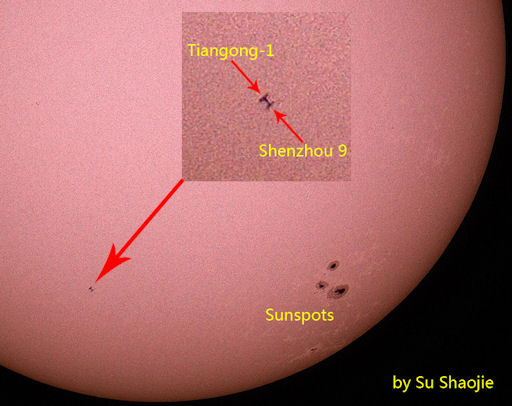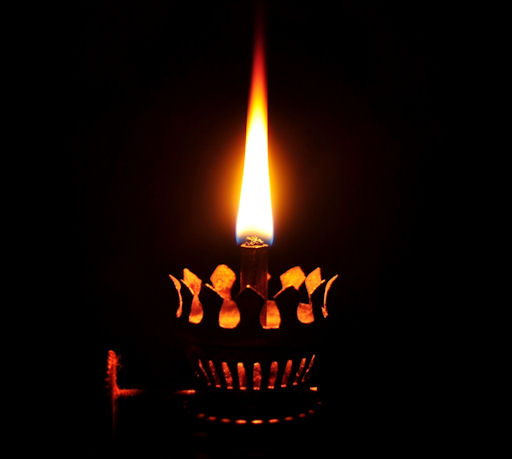HAPPY SOLSTICE: Today, the sun crosses the celestial equator heading south. The moment of crossing or "solstice" occurs at 7:09 pm EDT and marks the beginning of northern summer. This is the longest day and shortest night of the year in the Northern Hemisphere. Meanwhile In the Southern Hemisphere, winter begins. Happy solstice!
CHINESE SPACE TRANSIT: China's space program took another leap forward this week when Chinese astronauts onboard the Shenzhou 9 spacecraft successfully docked with the Tiangong 1 space station. Not long after the docking, which occured on Monday, June 18th, the joined spacecraft passed directly in front of the sun over Xinzhou, China, where amateur astronomer Su Shaojie recorded the split-second transit:

Photo details: Canon 450D camera, 104mm telescope, Baader solar filter, 1/2000 sec exposure , ISO100
"After the Shengzhou 9 successfully docked with Tiangong-1 at 14:07 Beijing time, I was happy to get this opportunity to take a picture of the two spaceship transiting the Sun," says Shaojie. "I used CalSky to predict the timing."
The mission's crew of three includes the first Chinese female astronaut, fighter pilot Liu Yang, 33. Yang, along with fellow taikonauts Commander Jing Haipeng, 46, and flight engineer, Liu Wang, 42, will spend the days ahead familiarizing themselves with their new space station, conducting scientific experiments, and practicing space dock procedures. They're expected to return to Earth before the end of the month.
The newly-manned Tiangong 1 is visible in the night sky, glowing about as brightly as a 1st magnitude star. Check the Simple Satellite Tracker or your smartphone for sighting opportunities.
SOLSTICE IN A SODA CAN: To commemorate the 2012 summer solstice, astronomer Rijk-Jan Koppejan has made an image of the sun--with an exposure time of six months. Every day from Dec. 2011 to June 2012, he used a solargraph to record the sun's motion across the skies of his observatory in Middelburg, the Netherlands:
A solargraph is a simple pinhole camera made from a soda or beer can lined with a piece of photographic paper. Koppejan deployed his solargraph in time to record last December's solstice (the lowest track in the image) and let it continue passively recording until June 19, 2012.
"Here in the Netherlands we think we didn't have much sunlight the last 6 months, but looking at this picture it wasn't too bad after all!" Koppejan says.
6-month Solargraph How-to Guides: #1, #2, #3
Realtime Space Weather Photo Gallery
FIRE LIT BY THE TRANSIT OF VENUS: Around the world on June 5th and 6th, millions of people watched the Transit of Venus. Only one man used it to light a candle. Christopher Handler of Adelaide, South Australia, explains how it was done: "The flame that burns in this lantern was lit with photons of light, of which about 0.001% had skipped through the atmosphere of another planet." (continued below)
"While watching the transit with my wife and son, I began to write words on a piece of wood with a magnifying glass, while explaining to my son that some of the sunshine we were using had bounced off the clouds of Venus only minutes earlier. Before long, we had lit a small fire in some kindling and from that lit several candles around the house. The hours passed by and the transit was over, yet we still have the flame. Captivated by the thought that it will take another 105 years before it could be done on Earth again, I feel almost compelled to keep it alight, even now, many days later."
A thousand more unique photos of the event may be found in the Transit of Venus gallery. Note: When you're browsing the gallery, please vote for your favorite images. We'll be creating a gallery of the most popular shots--and your votes count

![]()
Solar wind
speed: 360.0 km/sec
density: 1.9 protons/cm3
explanation | more data
Updated: Today at 1347 UT
![]()
X-ray Solar Flares
6-hr max: C1 1108 UT Jun20
24-hr: C1 1108 UT Jun20
explanation | more data
Updated: Today at: 1300 UT
![]()
![]()
![]()
Daily Sun: 20 Jun 12
![]()
![]()
Sunspot 1504 is decaying and poses a declining threat for M-class solar flares. Credit: SDO/HMI
![]()
![]()
![]()
Sunspot number: 64
What is the sunspot number?
Updated 19 Jun 2012
Spotless Days
Current Stretch: 0 days
2012 total: 0 days (0%)
2011 total: 2 days (<1%)
2010 total: 51 days (14%)
2009 total: 260 days (71%)
Since 2004: 821 days
Typical Solar Min: 486 days
Updated 19 Jun 2012
The Radio Sun
10.7 cm flux: 118 sfu
explanation | more data
Updated 19 Jun 2012
![]()
![]()
![]()
Current Auroral Oval:
![]()
Switch to: Europe, USA, New Zealand, Antarctica
Credit: NOAA/POES
![]()
![]()
![]()
Planetary K-index
Now: Kp= 1 quiet
24-hr max: Kp= 2 quiet
explanation | more data
![]()
Interplanetary Mag. Field
Btotal: 5.4 nT
Bz: 3.4 nT north
explanation | more data
Updated: Today at 1346 UT
![]()
![]()
![]()
Coronal Holes: 19 Jun 12
![]()
![]()
There are no large coronal holes on the Earthside of the sun. Credit: SDO/AIA.






